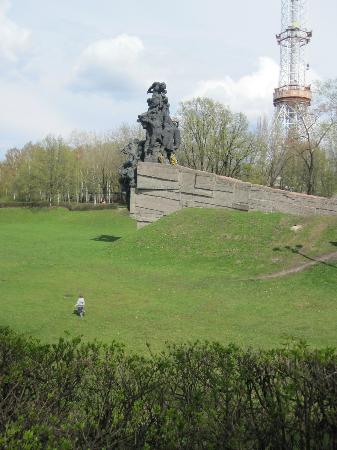My apartment in Kyiv was right across the street from my work. It was in Lukianivska district – not too far away from the bazaar. I primarily decided to move there after experiencing the classic Kyiv travel conundrum: riding the metro to get to work meant a steaming train car filled with many people who did not use deodorant and one had to run into the car to force enough room for you to get in before the doors closed together. Fighting for your breathe in a hot metro train car while being pushed aside in order for the next working man or woman to elbow you in the ribs in order to make room for themselves is not the ideal start of a working day. So off I went to my old Soviet apartment block with no shower curtain but a much appreciated washing machine (paid extra for that, but well worth it. Seriously, one of the guys I went to see an apartment about told me that although he didn’t have a machine, I can always go to my friend’s place – which is across the city – wash my clothes there, bag them up, bring them back to the apartment and hang dry them there. I said no and walked out).
Growing up in the Ukrainian community in the Diaspora, one doesn’t really hear stories of other peoples’ suffering during the Second World War. It’s usually a recap of the Ukrainian side: the UPA, the occupation, the assholishness of the Soviets (seriously, major assholes!) – but not really the full scale implementation of killing on Ukrainian territory. That’s how I first heard about Babi Yar – some place where thousands got killed but the concrete information was vague. There were Ukrainian nationalists, of course, but who else? These questions were not regularly explained (or maybe they were and I just wasn’t listening).
Back to Kyiv though – I decide to go for a walk. Its late autumn, most of the trees have shed their leaves and there’s always a rich red sunset out of my window. There’s a radio tower that I consider my own Eiffel Tower surrounded by trees. Is there a park over there? I have a freakin’ park near me? Well – worth a day trip!
I set off and wonder down the street for about 20 odd minutes. And there is: big, open and green. And then I glance down at my ever present map: Babi Yar. Shit! This is Babi Yar? THE Babi Yar? I have Babi Yar in my backyard? I feel both excited (history freak here) and anxious. The magnitude of the place is overpowering. At first there are the smaller commemorative plaques: I remember the plaque for the Ukrainian Nationalists – Olena Teliha for one. She lived down the street from this place and in the end this is where she met her fate: for being a Ukrainian intellectual, a Ukrainian woman and a Ukrainian nationalist. She was on the wrong side of history it seems.
And then I glance up from reading the names of the Ukrainian Nationalists and there it is: the gorge. It’s massive. Its magnitude is only overshadowed by the thousands of people who were killed in it. Women, men, children, the elderly, Jews, gypsies, Ukrainians, Soviets, collaborators, traitors, heroes and civilians. Whatever you want to address them as, in this place they came together in what Jan Gross terms, “sameness” (although he uses it describe Soviet massacres, but it is easily transferable from one evil to another). In this pit, or right on its perimeter, it did not matter who you were, what religion you were, what your political believes were or where you came from, a bullet was all it took to turn you into equals. A bullet laced with hatred, a contorted world view and an ideology that allowed you to think you were better than another human being. A bullet that was held by someone who looked at a child and thought of deprivation and filth. This is what Babi Yar represents: an example to never allow that way of thinking to come into being again. Ukrainians are not better than Jews, Jews are not better or worse than Poles and men are not superior to women.
It’s moving – the pit. It’s green now and open to the elements. The huge statue commemorating all those thousands who died stands out over it: its shadow mimicking that of a warped sun dial. I walk around it, take pictures and then I notice the dogs playing inside it with their owner standing off the side. In the pit. I feel disgusted. I want to scream: ‘do you not know?’ Why would anyone want to be in there? Do you not know what happened here?
I walked away. I prayed, I said my farewells and I walked away. How do you commemorate this? What is the best way of remembering all those who died in such horrible and tragic ways – just for being? I guess that is the question many are asking themselves in Ukraine: how do we remember the conflicting, confusing and at most time’s complex history of Ukraine? Maybe it is simply just by having open parks where dogs can play? Where life can be allowed to grow and flowers allowed to blossom? Hopefully, we’ll be able to find out.




GIPHY App Key not set. Please check settings